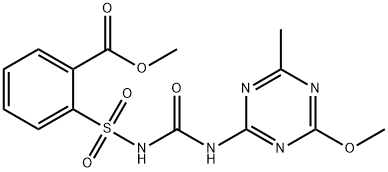METSULFURON METHYL
- CAS NO.:74223-64-6
- Empirical Formula: C14H15N5O6S
- Molecular Weight: 381.36
- MDL number: MFCD00128061
- SAFETY DATA SHEET (SDS)
- Update Date: 2025-12-07 19:09:50

What is METSULFURON METHYL?
Chemical properties
Light yellow solid
Chemical properties
White, off-white or pale yellow crystalline solid. Slight, sweet odor; ester-like.
The Uses of METSULFURON METHYL
Herbicide.
The Uses of METSULFURON METHYL
Metsulfuron-methyl is a triazine urea herbicide used to control broad-leaved weeds in barley and wheat.
The Uses of METSULFURON METHYL
Metsulfuron-methyl is an organic micro-pollutant.
Definition
ChEBI: A N-sulfonylurea in which the sulfonyl group is attached to a 2-(methoxycarbonyl)phenyl group while a (4-methoxy-6-methyl-1,3,5-triazin-2-yl group replaces one of the amino hydrogens of the remaining urea group.
Agricultural Uses
Herbicide: Metsulfuron-methyl is a pre-emergence and post-emergence herbicide used to control annual grasses, brush, woody plants and broadleaf weeds. It can be applied to cereals including barley, rye and wheat and to pastures. It is primarily used to control brush, woody plants and broadleaf weeds on rights-of-way, fence rows, storage areas, highways and other non-crop areas.
Trade name
ALLIE®; ALLY®; ALLY-20DF®; ANSWER®; BRUSH-OFF®; CANVAS®; CIMARRON®; DMC® WEED CONTROL; DPD 63760H®; DPX 6376®; DPX-T 6376®; ESCORT®; FINESSE®; GROPPER®; NUP®; PARTISAN ®; PASTURE® MD; RIVERDALE®; ROSULFURON®
Potential Exposure
Metsulfuron-methyl is a preemergence and postemergence sulfonylurea herbicide used to control annual grasses, brush, woody plants and broadleaf weeds. It can be applied to cereals including barley, rye and wheat and to pastures. It is primarily used to control brush, woody plants and broadleaf weeds on rights-of-way, fence rows, storage areas, highways and other noncrop areas.
Environmental Fate
Soil/Plant. Hydrolyzes in soil and plants to nontoxic products (Hartley and Kidd,
1987). The half-life in soil varies from 7 days to 1 month (Hartley and Kidd, 1987).
Ismail and Lee (1995) studied the persistence of metsulfuron-methyl in a sandy loam
(pH 5.1) and clay soil (3.1) under laboratory conditions. Degradation was more rapid in
non-sterilized than in sterilized soil. In non-sterilized soil, the rate of degradation increased
with increasing soil moisture content. When the moisture level in the sandy loam and clay
soil was increased from 20 to 80% of field capacity at 35°C, the half-lives were reduced
from 9.0 to 5.7 and 11.2 to 4.6, days, respectively. The investigators concluded that the
disappearance of metsulfuron-methyl in soil resulted from microbial degradation and
chemical hydrolysis.
Metabolic pathway
In soils, under aerobic conditions, metsulfuron methyl is degraded by the cleavage of the sulfonylurea linkage, resulting in the formation of methyl 2- (aminosulfonyl)benzoate, 4-methoxy-6-methyl-2-amino- 1,3,5-triazine, and saccharin as major products. Under anaerobic conditons, free acid of metsulfuron methyl and the resulting O-demethylation product are identified. The formation of two ring-opening products at the triazine moiety is observed. Under acidic conditions, hydrolytic degradation products identified are involved in the soil degradation products. In plants, the specific metabolites are identified as the hydroxylation product of the phenyl ring of metsulfuron methyl and 4-methoxy-6-hydroxymethyl-2-amino-1,3,5- triazine. Mammalian metabolites are also included in the soil metabolites.
Shipping
UN3077 Environmentally hazardous substances, solid, n.o.s., Hazard class: 9; Labels: 9-Miscellaneous hazardous material, Technical Name Required.
Incompatibilities
Strong oxidizers. Stable in air to about 140 C. It is hydrolyzed in acid solutions.
Waste Disposal
It is the responsibility of chemical waste generators to determine the toxicity and physical properties and of a discarded chemical and to properly identify its classification and certification as a hazardous waste and to determine the disposal method. United States Environmental Protection Agency guidelines for the classification determination are listed in 40 CFR Parts 261.3. In addition, waste generators must consult and follow all regional, national, state and local hazardous waste laws to ensure complete and accurate classification and disposal methods. Recycle any unused portion of the material for its approved use or return it to the manufacturer or supplier. Offer surplus and nonrecyclable solutions to a licensed disposal company. Dissolve or mix the pesticide with a combustible solvent and burn in a chemical incinerator equipped with an afterburner and scrubber.
Properties of METSULFURON METHYL
| Melting point: | 158°C |
| Boiling point: | 181°C (rough estimate) |
| Density | 1.4561 (rough estimate) |
| refractive index | 1.6460 (estimate) |
| storage temp. | 0-6°C |
| solubility | DMSO (Slightly), Methanol (Slightly, Heated) |
| form | neat |
| pka | 2.55±0.10(Predicted) |
| form | Solid |
| color | White to Off-White |
| Water Solubility | 27mg/L(temperature not stated) |
| BRN | 587472 |
| CAS DataBase Reference | 74223-64-6(CAS DataBase Reference) |
| EPA Substance Registry System | Metsulfuron-methyl (74223-64-6) |
Safety information for METSULFURON METHYL
| Signal word | Warning |
| Pictogram(s) |
 Environment GHS09 |
| GHS Hazard Statements |
H410:Hazardous to the aquatic environment, long-term hazard |
| Precautionary Statement Codes |
P273:Avoid release to the environment. P391:Collect spillage. Hazardous to the aquatic environment P501:Dispose of contents/container to..… |
Computed Descriptors for METSULFURON METHYL
METSULFURON METHYL manufacturer
New Products
4,4-Difluoropiperidine hydrochloride tert-butyl 9-methoxy-3-azaspiro[5.5]undecane-3-carboxylate Indole Methyl Resin N-Isopropylurea N,N-Dicyclohexylcarbodiimide(DCC) MELDRUMS ACID 5-METHYLISOXAZOLE-4-CARBOXYLIC ACID Magnessium Bis glycinate Zinc ascorbate 1-bromo-2-butyne 2-acetamidophenol 9(10H)-anthracenone Erythrosin B, 4-Piperidinopiperidine 2-((4-morpholinophenylamino) (methylthio) methylene) malononitrile 2,4-dihydroxybenzaldehyde 3-(4-morpholinophenylamino)-5-amino-1H-pyrazole-4-carbonitrile Methyl 2-methylquinoline-6-carboxylate 2,6-dichloro-4-nitropyridine 4-Bromo-2-chlorobenzonitrile 2-(benzylamino)acetic acid hydrochloride 4-(tert-Butoxycarbonylamino)but- 2-ynoic acid 3,4-dihydro-2H-benzo[b][1,4]dioxepine 1-Phenyl-1-cycloprppanecarboxylicacidRelated products of tetrahydrofuran








You may like
-
 74223-64-6 98%View Details
74223-64-6 98%View Details
74223-64-6 -
 Metsulfuron methyl 98%View Details
Metsulfuron methyl 98%View Details
74223-64-6 -
 74223-64-6 Metsulfuron methyl 98%View Details
74223-64-6 Metsulfuron methyl 98%View Details
74223-64-6 -
 Metsulfuron-methyl CAS 74223-64-6View Details
Metsulfuron-methyl CAS 74223-64-6View Details
74223-64-6 -
 Metsulfuron-methyl CAS 74223-64-6View Details
Metsulfuron-methyl CAS 74223-64-6View Details
74223-64-6 -
 Metsulfuron Methyl 20 Wp Herbicide, 25 kg, BagView Details
Metsulfuron Methyl 20 Wp Herbicide, 25 kg, BagView Details
74223-64-6 -
 Liquid Metsulfuron Methyl 20% WP ChemicalView Details
Liquid Metsulfuron Methyl 20% WP ChemicalView Details
74223-64-6 -
 Metsulfuron Methyl 20 % Wp, 8 GMView Details
Metsulfuron Methyl 20 % Wp, 8 GMView Details
74223-64-6
